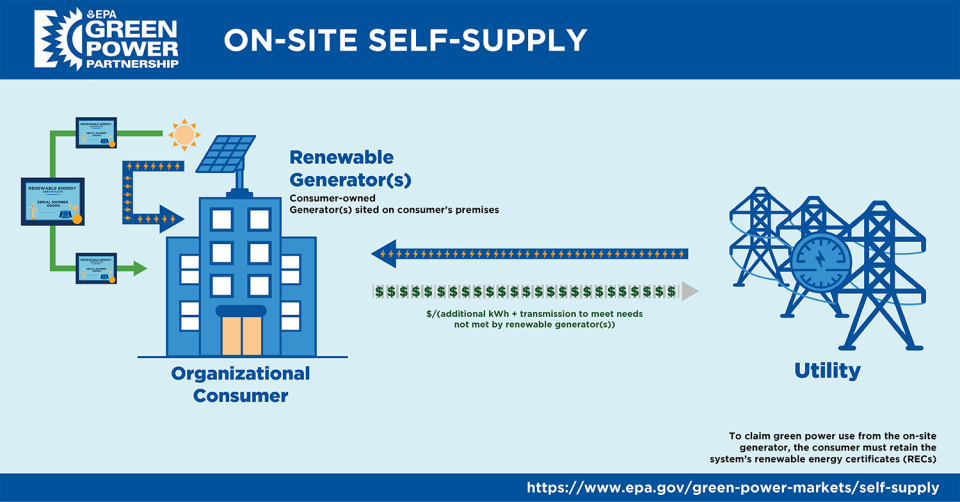Self-Supply
Explore the sections below to learn more about self-supply.
- What Is Self-Supply?
- How Does Self-Supply Work?
- Advantages and Challenges of Self-Supply
- Additional Resources
What is Self-Supply?
Self-supply refers to when the consumer is generating and supplying their own green power.
How Does Self Supply Work?
Self-supply arrangements can be structured in a number of ways. The renewable electricity generator may be directly connected at or near the point of use by the consumer; be off-site with the electricity being grid-delivered to the consumer; or be off-site with the power sold to others but the renewable energy certificates (RECs) retained by the consumer. In all arrangements, the consumer must retain ownership of the RECs associated with their renewable electricity generator in order for their use to be considered self-supply of green power. Self-supply is often referred to as “on-site generation.”
Because renewable electricity systems used by consumers to self-supply green power require up-front capital investment, consumers often use tax benefits and incentives at the local, state, and federal levels to help reduce the cost of purchasing the system. In evaluating long-term costs, consumers also need to account for ongoing maintenance and operation costs and the duties of owning a renewable electricity system.
The below infographic depicts how a typical On-Site Self-Supply works.

Advantages and Challenges of Self-Supply
Advantages:
- Direct control over a system’s operations.
- The system owner chooses the structure, generation resource, size of system, and other attributes.
- Visible contribution to renewable electricity generation, which can enhance brand image.
- Potential cost savings and price hedging over traditional power sources.
- Avoids transmission and distribution losses associated with grid-delivered supply options.
- Potential reliability benefits.
- Some forms of self-supply harness energy that might otherwise be wasted (e.g., combined heat and power systems).
Challenges:
- Requires up-front capital investment, which can be prohibitive.
- Consumers may lack the necessary technical knowledge for maintenance duties.
- Is generally less feasible for non-profit organizations, as they cannot take advantage of enabling tax benefits and incentives.
- Site constraints can limit choice of renewable resource and size of system.
- Relatively smaller system sizes make economies of scale harder to achieve.
